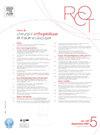Comment prendre en charge un syndrome du 2e rayon ?
Q4 Medicine
Revue de Chirurgie Orthopedique et Traumatologique
Pub Date : 2025-02-15
DOI:10.1016/j.rcot.2025.01.015
引用次数: 0
Abstract
Le syndrome du 2e rayon définit une instabilité douloureuse de la 2e articulation métatarso-phalangienne évoluant en 3 phases : du stade 1 au stade 3, on assiste à une désorganisation de l’avant-avant pied allant au-delà de l’atteinte de la seule 2e méta-tarsophalangienne perturbant le fonctionnement des orteils latéraux qui perdent leur appui pulpaire physiologique en se déformant. Sa cause principale est l’insuffisance fonctionnelle du 1er rayon, à l’origine d’un transfert de charge où l’hallux valgus prend la première place. D’autres étiologies plus rares intéressent des anomalies morphologiques sur le 2e métatarsien. Le traitement médical fait appel à l’infiltration de la MTP, actuellement controversée car masquant l’évolution naturelle du syndrome du 2e rayon sans en traiter l’origine. En effet, le traitement s’adresse à 3 registres différents, anatomique, étiologique et symptomatique. Le principal écueil du traitement anatomique de réparation chirurgicale de la plaque plantaire est qu’il confronte le patient à un risque non négligeable d’enraidissement de la MTP. Le traitement étiologique plus indirect a pour objectif, de diminuer les contraintes sur la métatarso-phalangienne par ostéotomie métatarsienne à ciel ouvert ou percutanées d’accourcissement ou de relèvement, en agissant également sur le premier rayon à l’origine des troubles. Sur le plan symptomatique on traitera les déformations des orteils latéraux en tentant de restituer un appui pulpaire au 2e ou 3e orteil, perdu du fait de la désorganisation de la balance des muscles intrinsèques et extrinsèques. Ce syndrome du deuxième rayon reste de traitement difficile avec des résultats inégaux notamment dans les stades les plus évolués. Il est exceptionnel que l’on obtienne une fonction strictement normale et stable dans le temps.
Niveau de preuve
V ; avis d’expert.
The 2nd ray syndrome depicts painful instability of the 2nd meta-tarsophalangeal joint, evolving in 3 phases. From stage 1 to stage 3, there is disorganization of the forefoot, going beyond involvement of the 2nd meta-tarsophalangeal joint alone, disrupting the function of the lateral toes, which lose their physiological pulpal support and become deformed. Its main cause is functional insufficiency of the 1st ray, resulting in a load transfer in which the hallux valgus takes precedence. Other, rarer etiologies involve morphological anomalies of the 2nd metatarsal. Medical treatment involves infiltration of the MTP, currently controversial because it masks the natural evolution of 2nd ray syndrome without treating its origin. Indeed, the treatment is aimed at 3 different levels, anatomical, etiological and symptomatic. The main drawback of anatomical treatment involving surgical repair of the plantar plate is a non-negligible risk of stiffening of the MTP for the patient. The more indirect aetiological treatment aims to reduce stress upon the meta-tarsophalangeal joint by means of shortening or elevation open metatarsal or percutaneous osteotomy, also acting on the first ray at the root of the problem. On a symptomatical point of view, lateral toe deformities are treated by attempting to restore pulpal support to the 2nd or 3rd toe, lost as a result of the disorganized balance of intrinsic and extrinsic muscles. Symptomatically, we treat lateral toe deformities by attempting to restore pulpal support to the 2nd or 3rd toe, lost as a result of the disorganized balance of intrinsic and extrinsic muscles. This second ray syndrome remains difficult to treat, with uneven results, particularly in the most advanced stages. Strictly normal function that remains stable over time is exceptional.
Level of evidence
V ; expert opinion.
如何处理第二射线综合症?
2e综合症定义了一个半径随着痛苦无常的第二关节métatarso-phalangienne体育场3阶段:第1阶段3年,出现了混乱状态l’avant-avant脚之外唯一的实现二次méta-tarsophalangienne脚趾外侧运行的干扰而失去生理pulpaire支助以及歪曲自己。它的主要原因是第一光束的功能缺陷,导致负载转移,其中光环valgus排在第一位。其他罕见的病因涉及第二跖骨的形态异常。医学治疗采用MTP渗透,目前存在争议,因为它掩盖了第二射线综合征的自然演变,而没有治疗其起源。事实上,治疗涉及三个不同的领域:解剖学、病因学和症状。对种植体斑块进行手术修复的解剖治疗的主要缺陷是,它使患者面临MTP硬化的重大风险。更间接的病因治疗的目的是通过开放或经皮的跖骨截骨术来减少对跖骨- phalangian的压力,这种截骨术也对引起疾病的第一根射线起作用。在症状方面,我们将治疗侧脚趾的畸形,试图恢复由于内部和外部肌肉平衡的破坏而失去的第二或第三个脚趾的肉质支撑。这种第二射线综合征仍然很难治疗,结果参差不齐,特别是在最先进的阶段。一个人在一段时间内得到一个严格正常和稳定的函数是例外的。证据水平;专家意见。第二射线综合征描述了第二跖骨关节疼痛的不稳定性,分3个阶段发展。从第1阶段到第3阶段,前脚出现了组织紊乱,这不仅仅是第2跖骨跖骨关节的参与,破坏了侧脚的功能,失去了生理上的牙髓支撑,变得畸形。它的主要原因是第一次射线功能不全,导致负荷转移,其中晕道valus优先。其他罕见的病因包括第二跖骨的形态学异常。医学治疗涉及MTP的渗透,目前有争议,因为它掩盖了第二射线综合征的自然进化,而没有治疗其起源。事实上,治疗的目标是3个不同的层次,解剖,病因和症状。涉及种植板手术修复的解剖治疗的主要缺点是患者MTP僵硬的不可否认的风险。更间接的病因学治疗旨在通过缩短或抬高开放性跖骨或经皮骨切除术来减少对跖骨关节的压力,也在问题根源的第一束起作用。从症状的角度来看,外侧跖骨畸形是通过试图恢复第二或第三跖骨的牙髓支撑来治疗的,牙髓支撑是由于内在和外侧肌肉平衡紊乱而失去的。有症状的,我们治疗外侧畸形,试图恢复第二或第三个脚趾的牙髓支撑,这是由于内在和外侧肌肉平衡紊乱而失去的。这种第二次射线综合征仍然难以治疗,结果参差,特别是在最先进的阶段。这是一个非常正常的函数,随着时间的推移保持稳定。证据的程度;专家观点。
本文章由计算机程序翻译,如有差异,请以英文原文为准。
求助全文
约1分钟内获得全文
求助全文
来源期刊

Revue de Chirurgie Orthopedique et Traumatologique
Medicine-Surgery
CiteScore
0.10
自引率
0.00%
发文量
301
期刊介绍:
A 118 ans, la Revue de Chirurgie orthopédique franchit, en 2009, une étape décisive dans son développement afin de renforcer la diffusion et la notoriété des publications francophones auprès des praticiens et chercheurs non-francophones. Les auteurs ayant leurs racines dans la francophonie trouveront ainsi une chance supplémentaire de voir reconnus les qualités et le intérêt de leurs recherches par le plus grand nombre.
 求助内容:
求助内容: 应助结果提醒方式:
应助结果提醒方式:


